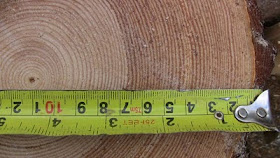I now have a year's source of wood for making fan birds - actually, it is probably more than ayears worth - it depends on how many I make and how many workshops I run.
The Forestry Commission at Haldon, Exeter let me have a Scots Pine tree. Ian Parsons (one of the rangers) and I choose the tree, straight grained and slow grown. This particular area was planted with Scots pine, and unfortunately the soil is not good so the trees never grew very fast, and do not have any real commercial value. They were planted in 1926ish, the biggest trees are about 14 inch diameter and the smallest are 5 to 6 inch diameter.

I like Scots pine, a native to this country; and not too resinous, unlike some of the other softwoods. It works very well green or dry and I have made small spoons from it in the past. I will also give it a go on the pole lathe and see if it makes a decent bowl.
The tree was felled at about 9.30am and by 11 am I had made my first fan bird from it. Some woods need to be mellowed or dried out a bit before use, but not this one.

I think this one tree could potentially make around 400 fan birds, and at an average of £20 each - that is good value from a tree that has a commercial value of £0 to £2 a cubic foot. It is interesting that for a maker, one tree might yield so much potential income.
Before you start rushing out booking onto my courses or just learning how to make fan birds, so you can make your fortune, there are a few things to remember. It is fine to make a whole batch of items but then you will need to sell them and that takes time and money. A certain amount of the stock can and will get damaged, especially with fan birds; and some will just fail as you make them - but that can be less with the more experience you have. Then there's all the fixed costs: workshop rent, insurance, van, etc. And the value of the time that it takes.
I would be interested in how other people can add value to trees. Unfortunately it is not the grower who gets much money for the wood as our forestry industry is depressed. The green woodworker is not a great consumer of wood and can make a little go quite a long way. We also can use wood that would be considered fire wood, thereby adding value to it. However, a lot of foresters do not really want to sell odd bits of wood to the occasional green woody: they want to sell it by the lorry load.
Great work with the fan birds, but with all due respect for your knowledge and skills, I would strongly recommend that you make the second cut/back cut higher and go down at an angle to meet the notch. You may have done it this way a thousand times sir, but I have seen trees slip back at the base very suddenly when a cut like yours has been made.
ReplyDeleteWhen this happens the top of the tree of course continues downward, but the butt of the tree can kick upward and backward. Never stand behind a tree away from where it will fall, always move to one side or the other.
With respect and regards, Le Loup.
Hi Sean,
ReplyDeleteYour post really speaks to me. I am both a woodworker and a landowner who has reforested about nine acres of our land, over 8,000 trees. The time has come to do a serious thinning, what foresters call a "pre-industrial" thinning, although I am not following that paradigm very closely. The softwoods, which are Red and White Pine, White and Blue Spruce, need to have every other tree removed. I've been pruning the trees over the years, and there are now several hundred potential logs about 8"- 10" in diameter, no branches for about ten feet up from the base, and, you know, I can't give the trees away! I have consulted foresters and loggers, and nobody will even come take them for free.
My last resort has been to girdle the trees, which means I'll have a huge amount of dead standing trees to invite insects, such as these really bad wasps that are invading the region and decimating softwoods. I wish I could figure out what to do with this timber before it becomes useless.
Regarding the felling process, a pro logger has told me that every tree requires an established exit path 45 degrees on both sides from the direction of the fall. In your case, with all that open space, it didn't seem to be a problem.
Your work is beautiful. I would very much like to learn your craft. Let me know if you ever come to Upstate New York.
Best,
Tico